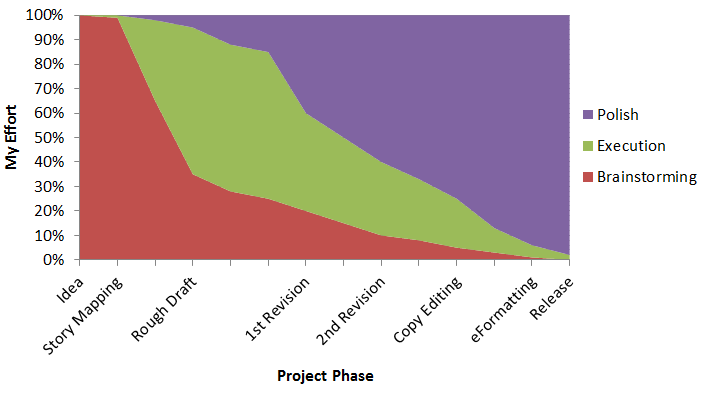First! I’ll be attending Arisia in Boston this weekend (1/16-1/18), and may be cosplaying one or more characters from A Togahan’s Tale. If you’re there and want to link up, contact me and we’ll figure out something convenient.
Second! Here’s a very geeky way I like to think about my writing process. Get yer nerd on and enjoy:
I boil my writing process down to three fundamental mindsets: Brainstorming, Execution, and Polish. All three are critical, but I won’t necessarily engage them one at a time. I’d summarize it with a graphic like this (because I like pictures):

The horizontal axis represents the various phases of authoring a novel. The vertical axis represents the percentage of all my writing time at a given stage. So at the end of my Rough Draft phase, I’m roughly 20% brainstorming, 65% execution, and about 15% polish.
Brainstorming is when all of the ideas come flying at me, and I need to just get them down so that I can organize them.
- Some of this is very organic (ideas occur to me while out walking, driving, or performing some other task, and I quickly write them down so that I can capture the idea.
- Some of it is very structured, like when I sit down with paper and pens to construct a mind map or story map.
In either case, the purpose is to capture the idea without a lot of detail, and maybe see where a scene/character/technology fits into the story. Story mapping is also where I’ll identify what’s missing, and what other plot points I need to fill in.
Execution is the actual writing. This is where I refer to my story map and then start narrating with the keyboard.
- I’ll construct all the exposition and dialogue, and move through the story scene by scene.
- As the minute details unfold, I might go back and brainstorm where I arrive at gaps. For instance, I might be telling the story and reach a point where a character relays some relevant history lesson or myth that’s critical to the story. I’ll take a break, brainstorm the myth, and then come back to the story, referring to only the pertinent parts of the myth.
Execution produces most of the story’s raw material, and takes longer than Brainstorming, but not as long as Polish.
Polish is where I clean it up for the reader.
- First I’ll go through each chapter scene by scene to determine whether that scene adds value and correct the story where it doesn’t.
- I’ll go through a second sweep and correct the grammar, punctuation, and word choice.
- Then I’ll release an early draft to my beta readers. They’ll point out the large flaws they see (characters that don’t make sense, scenes that don’t work, dialogue that’s stiff, slow pacing etc.).
- From their feedback I’ll determine what needs to be changed, do that, and then perform one final sweep to tighten up the writing.
- Then it’s off to the copy editor. She’ll mark all the bad punctuation, grammar, and other fine mistakes that I missed. I refer to this as “moving 4,000 commas”, because I’ll be deleting and adding commas all over the place. (I’m sure the grammarians among you are already sharp shooting this article).
Polish is the longest phase, just because there are so many sweeps and so many people involved. During Polish I might brainstorm a few solutions, and execute a new scene or two, but as much as I want to improve the manuscript, I also resist the urge to tinker with it too much. At this point, the story is what it is. Polish also includes adding the front and back matter (cover art, maps, acknowledgements, copyright page, etc.), and then formatting the final manuscript for e-release (converting from Word to ePub and.mobi formats).
One thing I need to be careful of is brainstorming too much during the Polish phase. The risk here is that while I might introduce some new interesting bit, I might also introduce a contradiction, and possibly a passage that my copy editor hasn’t reviewed. It can and should be done when necessary, but always with caution.
This is how I do it. Every author has their process, and after nearly twenty years of writing, this is what works for me. If you do something completely different and it works, by all means keep doing it. Many authors prefer to dive right into the Execution, but they’ll also find that their Polish phase is longer as a result. In the end, I don’t think either method is faster or more efficient; it all depends on what gets the job done.
What does your process look like? Let me know in the comments.
